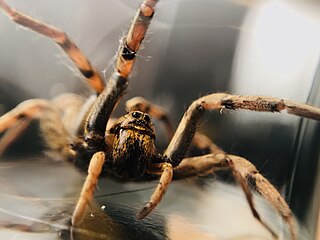
Wolf spiders are members of the family Lycosidae, from the Ancient Greek word "λύκος" meaning "wolf". They are robust and agile hunters with excellent eyesight. They live mostly in solitude and hunt alone, and do not spin webs. Some are opportunistic hunters pouncing upon prey as they find it or even chasing it over short distances. Some wait for passing prey in or near the mouth of a burrow.

Ground spiders comprise Gnaphosidae, the seventh largest spider family with nearly 2,000 described species in over 100 genera distributed worldwide. There are 105 species known to central Europe, and common genera include Gnaphosa, Drassodes, Micaria, Cesonia, Zelotes and many others. They are closely related to Clubionidae. At present, no ground spiders are known to be seriously venomous to humans.

Oecobiidae, also called disc web spiders, is a family of araneomorph spiders, including about 100 described species. They are small to moderate sized spiders (about 2 to 20 millimetres long combined head and body length, depending on the species. Larger ones tend to be desert-dwelling. The legs are unusually evenly placed around the prosoma; most other spiders have some legs directed clearly forward and the rest clearly backward, or all forward. The first two pairs of legs of many Oecobiids point forward then curve backwards; somehow in a running spider this gives a curiously scurrying, wheel-like impression that is characteristic of many Oecobiidae, and is helpful as a rough-and-ready aid to identification in the field. Characteristic of the family is the anal gland; it bears a tuft of long hairs. Typical colour patterns range from dark-patterned cream in some smaller species, to a small number of symmetrically-placed, conspicuous round light spots on a background that may be anything from a dull orange colour to black. The carapace is rounded and bears a compact group of six to eight eyes medially situated near the front of its dorsal surface.
Pristobaeus is a genus of jumping spiders that was first described by Eugène Louis Simon in 1902.

Telamonia is a genus of jumping spiders that was first described by Tamerlan Thorell in 1887. They are colorful spiders, with patterns that vary considerably between sexes and species. Two longitudinal stripes along the abdomen are common, and the carapace is often colored. They have a slender opisthosoma and long legs.
Thianella is a possible monotypic genus of jumping spiders containing the single species, Thianella disjuncta. It was first described by Embrik Strand in 1907, and is found only on Java. Based on a male specimen, Roewer placed it close to Thiania, but his placements of salticids have often been questionable and no drawings currently exist. The name is an alteration of the salticid genus Thiania, and the species name is from Latin disiunctus "separated". The World Spider Catalog regards the genus and species names as nomina dubia.

Microstigmatidae is a small family of spiders with about 25 described species in eight genera. They are small ground-dwelling and free-living spiders that make little use of silk.

Agelena is a genus of agelenid spiders first described by Charles Athanase Walckenaer in 1805. Sometimes referred to as Eurasian grass spiders, they trap their prey by weaving entangling non-sticky funnel webs. They are limited to the Old world, occurring from Africa to Japan.
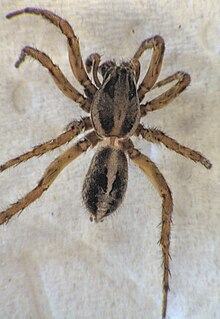
The Artoriinae are a subfamily of wolf spiders. The monophyly of the subfamily has been confirmed in a molecular phylogenetic study, although the relationships among the subfamilies was shown to be less certain.

Idiops is a genus of armored trapdoor spiders that was first described by Josef Anton Maximilian Perty in 1833. It is the type genus of the spurred trapdoor spiders, Idiopidae. Idiops is also the most species-rich genus of the family, and is found at widely separated locations in the Neotropics, Afrotropics, Indomalaya and the Middle East. Females live in tubular burrows lined with a thick layer of white silk. These typically have a D-shaped lid that fits into the entrance like a cork, and some burrows have two entrances. The lid may consist of mud, moss or lichen, which is bound below by a thick layer of silk. As in all genera of this family, the anterior lateral eyes (ALE) are situated near the clypeal margin, far in front of the remaining six eyes, which are arranged in a tight group. The males which are smaller in size, wander about or occasionally live in burrows. Like other mygalomorphs, they are relatively large and long-lived. Forest clearance and agricultural practices that loosen the soil and enhance erosion, besides soil removal for brick making have been pointed out as serious threats to some Indian species. Species ranges are poorly known – in India for instance, most species are known only from their type localities.

Trochosa is a large wolf spider genus found worldwide.
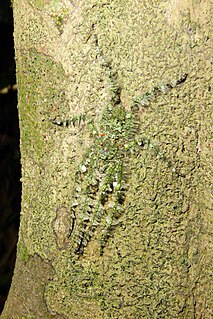
Pandercetes is a genus of huntsman spiders that was first described by Ludwig Carl Christian Koch in his 1875 treatise on Australian spiders. They are mainly distributed in tropical Asia and Australia, and are known for their cryptic coloration that matches local moss and lichen. Their legs have lateral hairs, giving them a feathery appearance, further masking their outline against tree trunks. Their head is somewhat elevated and the carapace has the thoracic region low and flat.
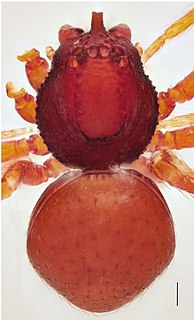
Brignoliella is a genus of araneomorph spiders in the family Tetrablemmidae that was first described by W. A. Shear in 1978.
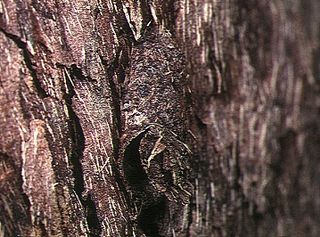
Conothele is a genus of mygalomorph spiders in the family Halonoproctidae, first described by Tamerlan Thorell in 1878. Originally placed with the Ctenizidae, it was moved to the Halonoproctidae in 2018.

Ablemma is a genus of araneomorph spiders in the family Tetrablemmidae that was first described by Carl Friedrich Roewer in 1963.
Novakiella is a genus of South Pacific orb-weaver spiders containing the single species, Novakiella trituberculosa that has only been found in Australia and New Zealand.
Asiabadus is a monotypic genus of Asian ground spiders containing the single species, Asiabadus asiaticus. It was first described by Carl Friedrich Roewer in 1961, and has only been found in Central Asia and Afghanistan. It is named after Asiabad, a province in Afghanistan where they were first found, but it has been misspelled as "Asiadab" in generic and species headings.
Badia rugosa is species of Senegalese palp-footed spiders. It is the only species in the monotypic genus Badia. The species and genus were first described by Carl Friedrich Roewer in 1961. It is only found in Senegal.
Acontius is a genus of wafer trapdoor spiders that was first described by Ferdinand Karsch in 1879.












